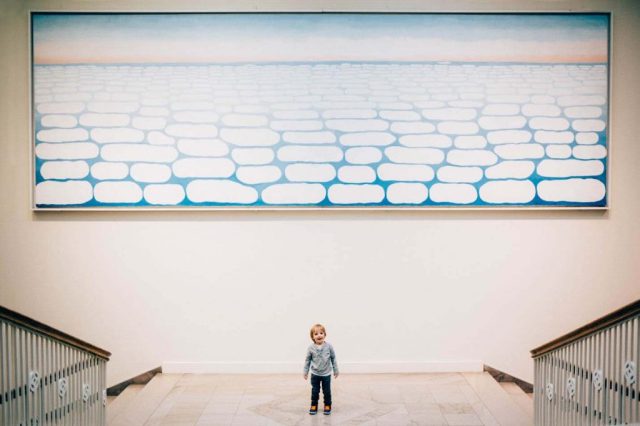Visiting the art museum gives you more than just a view of beautiful artworks. You’ll probably feel a boost of creativity and inspiration as you walk through the space. It might even help reduce your stress—unless you’re a parent.
If the thought of visiting such a distinguished place with children in tow strikes you as anything but transcendent, you’re not alone. We think a successful museum visit really is possible, though, with a bit of advance planning and reasonable expectations. And when it comes down to it, the benefits of giving your kids (and yourself) such an experience are worth it.
I spoke with Melissa Tanner, Family Programs Educator at The Art Institute of Chicago about how to prepare for a family visit to the art museum. First, she suggested, familiarize yourself with the family-centered programs and resources at your city’s museum. Most offer kid-friendly maps or activities tailored to younger audiences. Tanner also suggested picking a few artworks to visit during your time at the museum, or focusing on one particular collection rather than attempting to see everything at once. “It really depends on your child and what they need for their experience to be an enjoyable one,” Tanner told me. “Maybe you’ll see one artwork; maybe you’ll see five; maybe you’ll be distracted by something else that’s not on your list.”
If your children have never visited an art museum, prepare them for what to expect when you arrive. When talking about museum manners, Tanner advises to “focus more on what they can do rather than all the things they shouldn’t. For example: we can take pictures of artworks we love as long as we aren’t using flash, and we can draw our own art while we’re at the museum as long as we’re using a pencil.”
Involving children in the role of caring for art will also encourage museum manners. “Conservation science a really cool job, and kids can help take care of the museum while they’re here,” Tanner says. “We begin every program talking about why we enjoy art with our eyes instead of our hands. There are oils in our hands, and even though we can’t see them, oils can be harmful to works of art over time. The reason we can have things that are really, really old is because people respect our art.” Kids will love the sense of being part of a mission to protect the museum and its treasures.
Once you’re at the museum, engage with your kids by interacting with the artworks you encounter. Talk about what you see. Ask very small children to point out colors and shapes or play ‘I Spy’ with an extra-large painting. Direct school-age kids to a particular piece, and think about what might be happening in the piece (if it’s a narrative) or how it makes you feel (if abstract). Asking open-ended questions and building on the concepts they already know will maximize learning during your time at the museum.
The art museum is a rich environment for learning and thinking creatively, but the ultimate goal should be for your kids to enjoy their experience. Take snacks or retreat to the café if you need a break. Many museums boast gardens, courtyards, or rooftops perfect for releasing pent-up energy and family rooms for hands-on art activities.
“Maybe your child won’t remember what artwork you saw together at age three, but at age four, they’ll remember they had fun that time at the museum, and they’ll want to go back,” assures Tanner. “When they’re five, they’ll remember something more, and so on.”
Museums encourage lifelong learning. As your children follow you through exhibits, they’ll begin to understand—whether consciously or not—that learning is for everyone. They’ll encounter opportunities to think critically[4] about new ideas and develop empathy for diverse perspectives. Their creativity, curiosity, and imagination will thrive as they bring to life the stories of artists and their artwork. Taking your family to the art museum isn’t such a risky idea after all. Turns out it’s one of the smartest.











